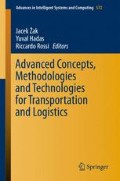Abstract
The problem of determining the stowage plan for each port included in the circular route of a containership is the planning problem daily faced by the shipping line coordinator (SC). The SC has to determine how to stow in each port a given set of containers into bay locations, either on the deck or in the hold, in order to satisfy some structural and operational constraints, all the transport demand and minimize the ship berthing time. The time spent by the ship at the ports is minimized when the SC defines a stowage plan that avoids re-handles, balances the workload of the cranes working in parallel at each port and requires to open and close hatches the least possible when moving containers in the holds. We propose a new MIP formulation, and a MIP heuristics for finding stowage plans for containerships up to 18000 TEUs. Moreover, the new formulation includes new and more accurate stability conditions.
Access this chapter
Tax calculation will be finalised at checkout
Purchases are for personal use only
References
Ambrosino, D., Anghinolfi, D., Paolucci, M., Sciomachen, A.: A new three-step heuristic for the master bay plan problem. Marit. Econ. Logistics (MEL) 11(1), 98–120 (2009). Special issue on “OR models in Maritime Transport and Freight Logistics”
Ambrosino, D., Paolucci, M., Sciomachen, A.: A MIP heuristic for the multi-port stowage planning. Transp. Res. Procedia 10, 725–734 (2015)
Ambrosino, D., Paolucci, M., Sciomachen, A.: Computational evaluation of a MIP model for multi-port stowage planning problems. Soft. Comput. 21, 1753–1763 (2017)
Delgado-Ortegon, A.: Models and Algorithms for Container Vessel Stowage Optimization. Ph. D. thesis, IT-Universitetet i København, ITU-DS, no. 99 (2013)
Imai, A., Nishimura, E., Papadimitriou, S.: Marine container terminal configurations for efficient handling of mega-containerships. Transp. Res. Part E 49(1), 141–158 (2013)
Meng, Q., Wang, S., Andersson, H., Thun, K.: Containership routing and scheduling in liner shipping: overview and future research directions. Transp. Sci. 48(2), 265–280 (2014)
Monaco, M.F., Sammarra, M., Sorrentino, G.: The terminal oriented ship stowage planning problem. Eur. J. Oper. Res. 239, 256–265 (2014)
Mulder, J., Dekker, R.: Optimization in container liner shipping. Econometric Institute Research Papers No. EI2016-05, Erasmus University Rotterdam, Erasmus School of Economics (ESE), Econometric Institute (2016)
Pacino, D., Delgado, A., Jensen, R.M., Bebbington, T.: Fast generation of near-optimal plans for eco-efficient stowage of large container vessels. In: Böse, J.W., Hu, H., Jahn, C., Shi, X., Stahlbock, R., Voß, S. (eds.) ICCL 2011. LNCS, vol. 6971, pp. 286–301. Springer, Heidelberg (2011). doi:10.1007/978-3-642-24264-9_22
Pacino, D., Delgado, A., Jensen, R.M., Bebbington, T.: An accurate model for seaworthy container vessel stowage planning with ballast tanks. In: Hu, H., Shi, X., Stahlbock, R., Voß, S. (eds.) ICCL 2012. LNCS, vol. 7555, pp. 17–32. Springer, Heidelberg (2012). doi:10.1007/978-3-642-33587-7_2
Pochet, Y., Wolsey, L.A.: Production Planning by Mixed Integer Programming. Springer, Berlin (2006)
Rashidi, H., Tsang, E.P.K.: Novel constraints satisfaction models for optimization problems in container terminals. Appl. Math. Model. 37, 3601–3634 (2013)
Rodrigue, J.P., Claude, C., Slack, B.: The geography of transport systems, 3rd edn. Routledge, London (2013)
Stahlbock, R., Voss, S.: Operations research at container terminal: a literature update. OR Spectr. 30, 1–52 (2008)
Steenken, D., Voss, S., Stahlbock, R.: Container terminal operation and operations research - a classification and literature review. OR Spectr. 26, 3–49 (2004)
Talley, W.K., Ng, M.: Maritime transport chain choice by carriers, ports and shippers. Int. J. Prod. Econ. 142, 311–316 (2013)
Tierney, K., Pacino, D., Jensen, R.M.: On the complexity of container stowage planning problems. Discrete Appl. Math. 169, 225–230 (2014)
UNCTAD. Review of maritime transport, 2014. United Nations Conference on trade and Development (2014)
Volkan, Ç.: Sustainable container terminal operations: challenges and enhancements. Karadeniz Araştırmaları, J. Black Sea Stud. 49, 141–156 (2016)
Wilson, I.D., Roach, P.A.: Container stowage planning: a methodology for generating computerised solutions. J. Oper. Res. Soc. 51(11), 1248–1255 (2000)
Wilson, D., Roach, P.A., Ware, J.A.: Container stowage pre-planning: using search to generate solutions, a case study. Knowl. Based Syst. 14(3–4), 137–145 (2001)
Acknowledgements
The authors thank Prof. Paola Gualeni and Prof. Massimo Figari of the Electrical, Electronics and Telecommunication Engineering and Naval Architecture Department (DITEN) of the University of Genova, Italy, for the support given in the definition of the stability ship constraints.
Author information
Authors and Affiliations
Corresponding author
Editor information
Editors and Affiliations
Rights and permissions
Copyright information
© 2018 Springer International Publishing AG
About this paper
Cite this paper
Ambrosino, D., Paolucci, M., Sciomachen, A. (2018). Shipping Liner Company Stowage Plans: An Optimization Approach. In: Żak, J., Hadas, Y., Rossi, R. (eds) Advanced Concepts, Methodologies and Technologies for Transportation and Logistics. EURO EWGT 2016 2016. Advances in Intelligent Systems and Computing, vol 572. Springer, Cham. https://doi.org/10.1007/978-3-319-57105-8_20
Download citation
DOI: https://doi.org/10.1007/978-3-319-57105-8_20
Published:
Publisher Name: Springer, Cham
Print ISBN: 978-3-319-57104-1
Online ISBN: 978-3-319-57105-8
eBook Packages: EngineeringEngineering (R0)

